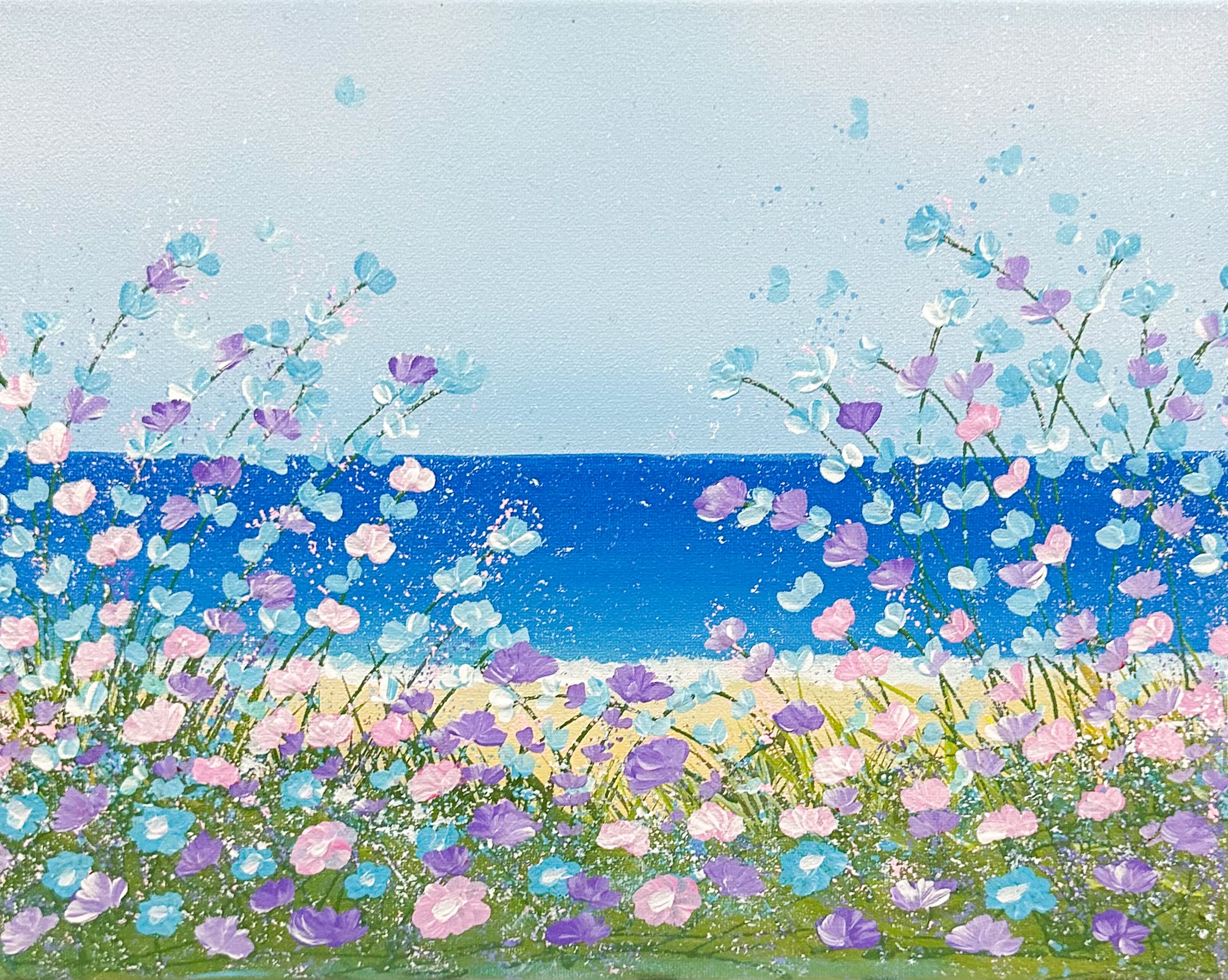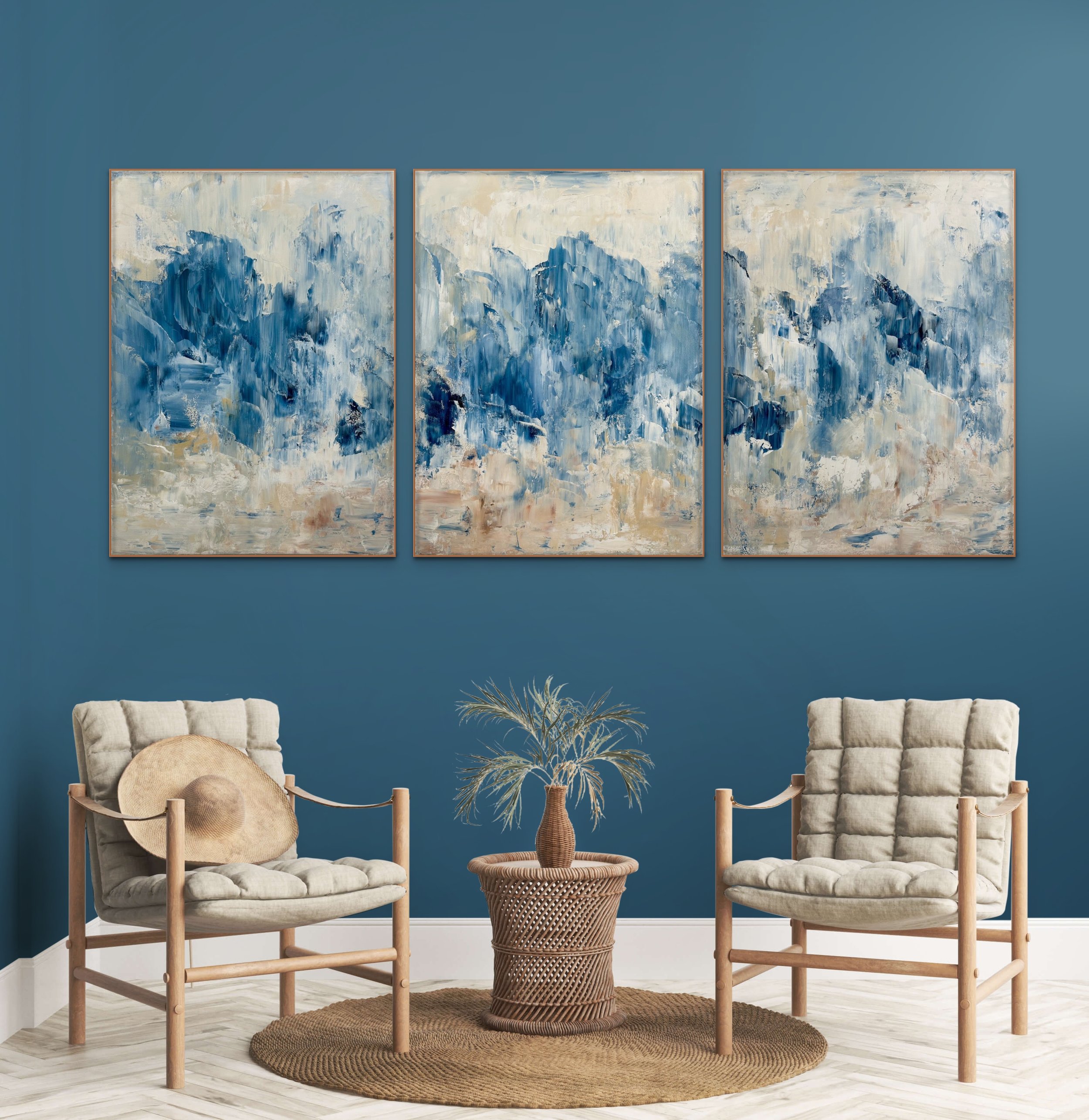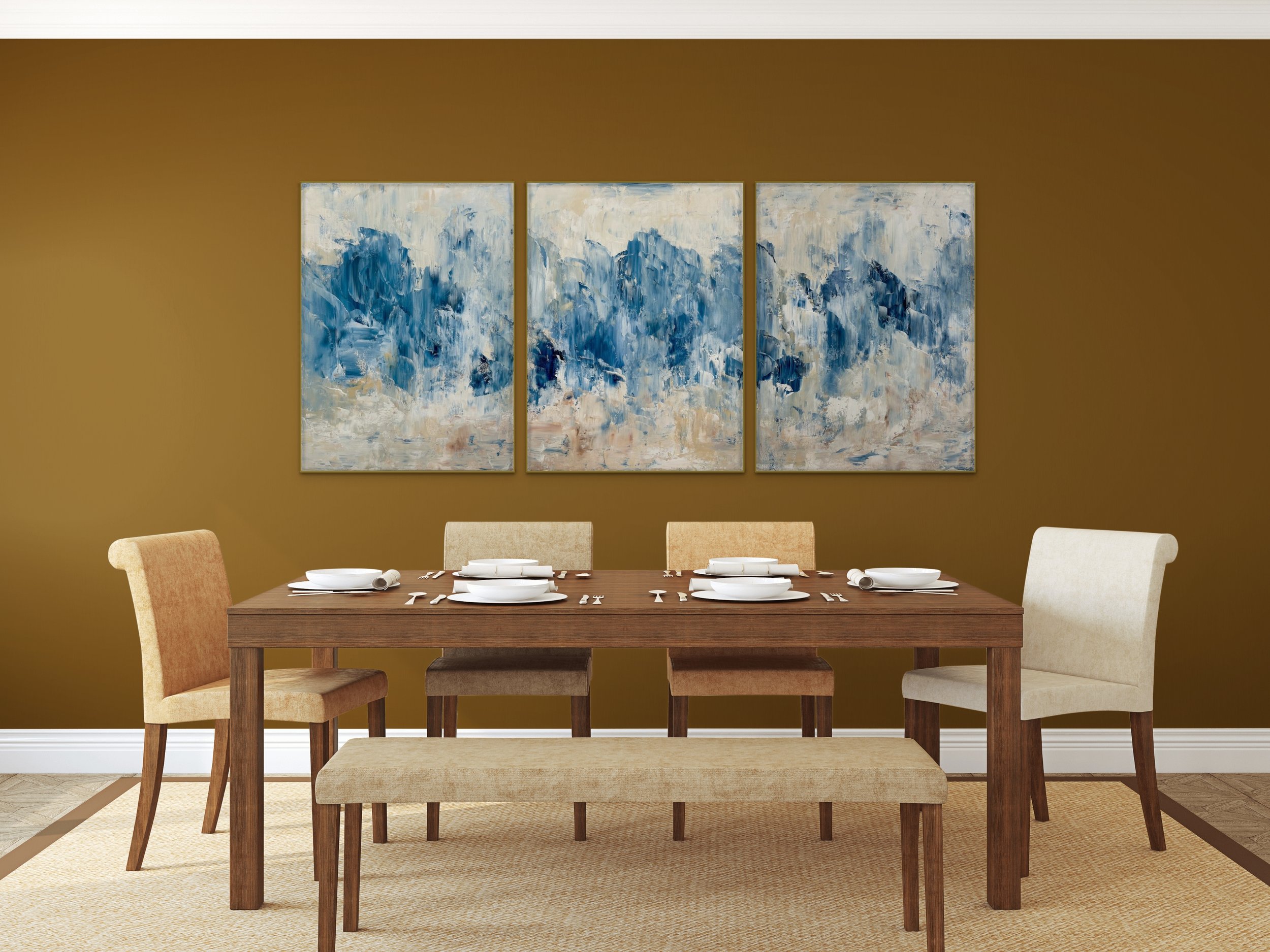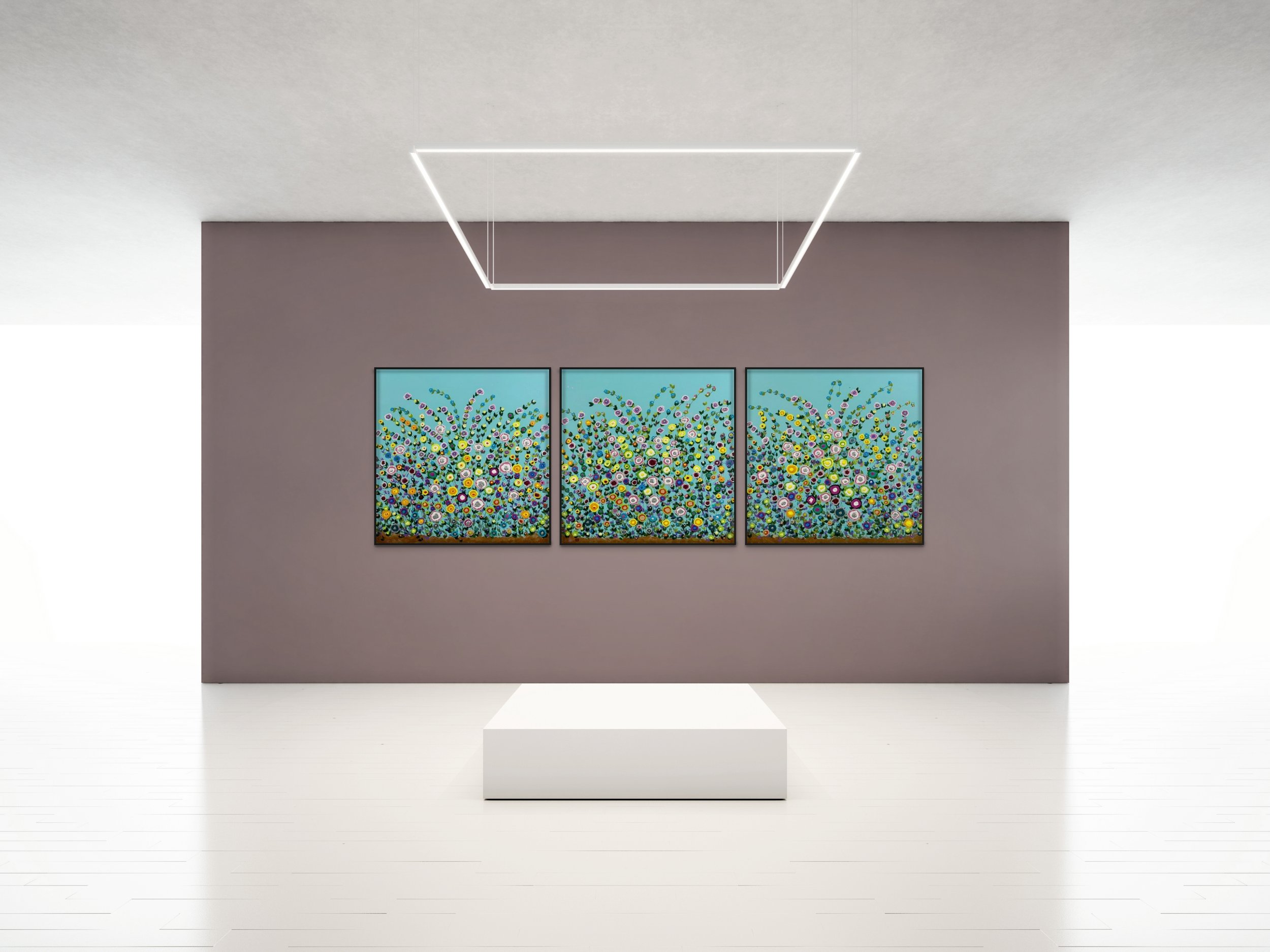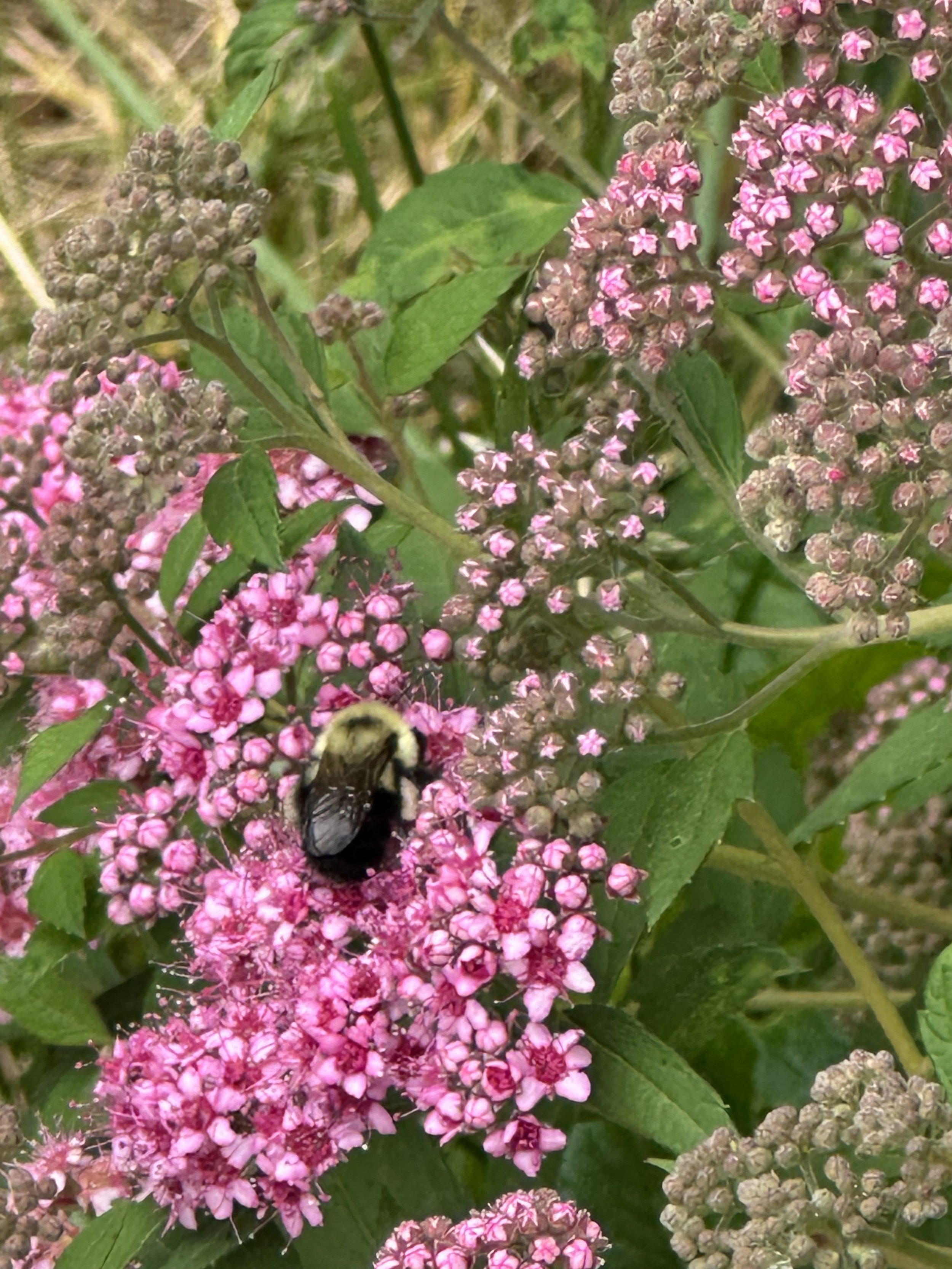Experimenting With Art And Health
I’m an artist and innovator in the field of art and health, so I like to experiment a lot.
Recently ARTPLACER.com, an art placement company I really enjoy, added patient rooms to their excellent selection of mockup photos. Today my happy evidence-based design art hangs in so many different physical settings, but I have always told people I never considered it a good fit for the inside of a hospital patient’s room.
With ARTPLACER’S new mockup photos, here was my chance to really experiment within the inside of patient rooms, so I did.
When I create evidence-based design art, I think back to when I needed two major surgeries in different parts of my body in less than 30 days. Through this experience I realized there were so many different stages involved—such as the in-hospital pre-operation stage, the in-hospital post-operation stage, and the at-home longterm recovery stage. I also realized how my needs were different during each stage.
Right after surgery, while in my patient room, I felt that my entire body had been seriously assaulted and traumatized—and it had. The hospital, the staff, and my two doctors were all excellent, but that’s just what happens when a human body needs major surgical operations.
While inside my patient room, what I needed most was a total relief from any additional stimulation or trauma. Most of my evidence-based art is strategically and deliberately designed to not stress, but it is also designed to stimulate.
The trick—or I should say the skill—as an evidence-based design patient room artist is to create a work of art that is lovely according to the evidence-based design guidelines but is also one that does not cause too much brain stimulation. The art should be lovely without impact.
Placing different pieces of my art in ARTPLACER’S new hospital rooms, I was able to do some experimenting and here are some things I discovered.
Very much to my surprise, some of my florals did very well, even in a darker patient room. They were lovely and uplifting and fit comfortably in this room without creating too much stimulation to the brain.
I was even more surprised to see that even my bolder evidence-based design florals succeeded. They clearly delivered happiness and cheer without causing any stress or trauma.
Here are some of my other evidence-based design paintings that I thought might just work inside a patient room. I have always felt that my ideal hospital patient room should have carefully selected works of real art on the wall. Bland, boring, stereotypical designs actually frighten me. It’s as if this art makes a kind of heart monitor flatline sound. For me, art is hyper visual but it’s also always full of music and sound.








Did You Know This About The Brain And Art?
Did you know many scientists, researchers, and medical experts have been studying our brains and art?
Did you know many scientists, researchers, and medical experts have been studying our brains and art?
Their many credible studies have even resulted in creating actual guidelines for evidence-based designers and artists to follow while creating designs/art that positively impacts the human brain and emotions.
With landscapes, waterscapes, and garden scenes, one guideline is to have visual depth or openness in the immediate foreground. A reason for this is that the depth or openness creates an absence of a threat or ambiguity—two things many humans do not like or fear.
Another guideline based on credible scientific/medical studies is to offer designs with warmer seasons, verdant vegetation, and flowers in bloom. Something I like to add to my art—calm or non-turbulent waters are also well received by the human mind and emotions.
I like to experiment with evidence-based design, so in this 1:22 minute video on 21st century Great Lakes art, many of these paintings feature non-turbulent water along with lush vegetation and flowers in bloom. The video’s theme was today’s Great Lakes art, but many of the paintings were created using evidence-based design guidelines developed by scientists, researchers, and medical experts.
Here are some close-up views of sold paintings that were created using many evidence-based principles and guidelines. In addition to meeting the evidence-based design guidelines, I build into each painting artistic qualities that trigger our brains to create feelings of happiness and joy. I’m always asked to do commissions of these, and they usually sell not long after being put on display. One newspaper writer referred to me an artist of happiness and hope. I believe it is because I translate very credible scientific/medical study results into works of art.
When I paint, my goal is not to reflect beauty in nature. My goal goes much deeper. It is to use the art to trigger the brain to create feelings of happiness.
Creating Joy In Abstract Art
Is it possible to create a modern work of abstract art that triggers the brain to create feelings of joy?
Is it possible to create a modern work of abstract art that triggers the brain to create feelings of joy?
Personally, I’m convinced of it. What is my reasoning? Buyers tell me all the time how happy my art actually makes them feel.
What’s the secret? Is it super talent or artistic genius or is it training and certification in Evidence-Based Design? I believe it’s a combination of talent and training. Based on established medical and scientific research, I know there are relationships between design factors and healthcare outcomes, especially when people view nature. I create and sell an abundance of nature scenes (see my websites dorotheasandra.com and the landscape category of thewonderfulworldofdorotheasandraart.com) but I also love to create and believe in abstract art as health and happiness sources.
I’m a member of The Society of Experimental Artists and also hold the EDAC (Evidence-Based Design Accreditation and Certification) designation, so I have a keen interest in trying new and different ways to create art.
Joyful Movements by Dorothea Sandra
In this triptych titled Joyful Movements, I experimented with using acceptable “evidence-based design” colors (soft and gentle) and combining them with “the abstract essences” of nature’s wind, rocks, sand, and water. Solely as an abstract work of art, Joyful Movements holds it own. The colors are amazingly beautiful and the palette knife movements create deep interest and intrigue.
My goal when designing this was to see if I could connect “evidence-based design” guidelines with “abstract art” techniques, so I stuck with “the essences” of nature—rather than identifiable shapes—for the purpose of keeping the composition free of too much impact and stress. I wanted this piece to be beautiful, but I also wanted it to do more for us. I wanted it to be gentle and soothing and to remind of us of nature’s amazing healing powers.
I wanted the brains of viewers to be reminded of nature’s water and sand and wind and rocks rather than to be touched (impacted) by them. Many of today’s neuroscientists have conducted studies on our brains and art. Professor Semir Zeki, a neurobiologist from the University of London, discovered in his studies: “When a person views art they find beautiful, it triggers an immediate release of dopamine into the brain—a chemical related to feelings of love, pleasure, and desire.”
Pierre Lemarquis, a French neuroscientist, concluded: “Art of all kinds acts on our brains in a multi-faceted dynamic way. Neural networks are formed to achieve heightened complex states of connectivity. Art can sculpt and even caress our brains.”
My overall desire for Joyful Movements was to achieve a work of art with moving nature essences that evoked in us feelings of happiness and healing.
Although this painting was created after 100 Days Of Happy Happy Art, Evidence-Based Design was published, here is an excerpt about designing with water from my book. There’s more to just painting water and nature elements when it comes to meeting all the evidence-based design standards.
For me to create “happy” art, I remember that the medical/scientific “evidence” matters.
“In evidence-based art, compositions with water should provide healing. Calm water scenes are preferred, while gushing rapids or crashing ocean waves should be avoided. Even a trickling water fountain might create negative experiences for people with full or nonfunctioning bladders.” (Distinctive Art Source, “Healthcare Art Bloopers,” 2023)
Today’s Mood Busting Art
Is it possible to bust through a bad mood with art?
Garden Holiday by Dorothea Sandra, EDAC
As many of you know, we live in “interesting” times. So many people today are stressed or sad or deeply troubled by something or someone. I like to use my art to fight against this by creating credible pieces that bust through these moods and create upward movement feelings of happiness and hope and joy. Using well-researched guidelines, I like to reach inside the brain through art and help shift a negative mood into something positive.
From the 1960s until today, serious researchers with very serious studies…from different countries…from different multidisciplinary fields have converged to create a new field of art called Evidence-based Design. According to the National Library of Medicine at the National Institute of Health, “Evidence-based design is scientific analysis methodology that emphasizes the use of data acquired in order to influence the design process in hospitals. It measures the physical and psychological effects of the built environment on its users.”
Today, evidence-based design isn’t just for hospitals. It’s for all of us. It is for many of the places humans go. What is my role in all of this? A very small one—but I think an important one. Today my art hangs in hospitals, businesses, organizations, and homes. Using my artistic talents and evidence-based design training and certification—just as I did in this triptych art called Happy Garden—I very deliberately and very strategically create happy, happy art for today’s built environments.
People often ask me where I get my inspiration for this style of painting I call Bubble Art. These photos of flowers come from just two of my yards in Northern Michigan. I live in a super clean, healthy environment and inspiration always seems to be all around me—everywhere I seem to look. Nature is a truly powerful healer. When we can’t be out in it, putting art on our walls that captures nature’s fun and beauty often helps.
(I keep 100 percent pesticide-free yards with many bee and butterfly friendly plants. The bees this years are plentiful. I have even seen up to 8-10 bees on one bush.)
In a Garden Holiday, I used my evidence-based knowledge to select the cheerful background color. I painted the flowers in soil to give the artwork a rooted to our life-giving earth feel. Flowers and stems are never similar or boring in nature, so I gave this work an abundance of fun-filled stem twists and turns, pops full of flowery color, and many hints of humor.
If you would like to learn a bit more about evidence-based design and see how I applied it to my art, my new book, 100 Days Of Happy Happy Art, Evidence-Based Design, is available through Amazon.
Creating Power And Beauty In Art
Powerful Beauty is an amazing artwork people love to see.
Powerful Beauty is an amazing piece that people just love to see.
At the opening reception for a summer gallery exhibit, I was standing in front of this painting while talking to a NYC handbag designer for two world-famous fashion brands (who also bought one of my paintings that evening) when a very tall, amazingly elegant woman brushed behind me and whispered, “I l-o-v-e this piece!”
What makes Powerful Beauty such a winner?
To begin with, it was strategically designed to arouse and grab and gently caress. It’s beauty was deliberate and intentional. I am above all else an abstract artist, but I also trained and got certified in evidence-based design. I support the idea of basing designs on actual medical and scientific studies for health and healing and, like the many tools and techniques I use as an artist, I don’t hesitate to use these evidence-based design rules and guidelines while creating even abstract art.
The goal for Powerful Beauty was to create something abstract and full of movement but also balanced, stable, and beautiful to view.
If you would like more information about an artist’s adventures with evidence-based design, check out the book 100 Days Of Happy Happy Art, Evidence-Based Design by Dorothea Sandra.
It’s not just an art book. There’s lots of really cool and thoughtful information in it like, “What Exactly Is The Definition Of Evidence-Based Design?” (Section 1.4) to “What Happens To Our Brains On Art?” (Section 3.1) and “What Is Neuroarts?” (Section 3.2).
So, where did I get the inspiration for this piece? My studio is located in a Great Lakes region surrounded by amazing bodies of water. Almost everywhere I go, I am surrounded by raw, authentic, super clean NATURE. At first sight, this area might look ordinary or just another stretch of beach with rocks and sand, but when you look deeper and capture “the essence” of what is happening all around, it’s truly amazing. There’s always some kind of power or beauty happening.












